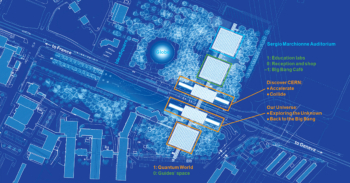Exhibition, Barcelona, 9 April – 24 September

Take a leap and enter, past the chalkboard wall filled with mathematical equations written, erased and written again, into the darkened room of projected questions where it all begins. What is reality? How do we describe nature? And for that matter, what is science and what is art?
Quàntica, which opened on 9 April at the Centre de Cultural Contemporània de Barcelona, invites you to explore quantum physics through the lens of both art and science. Curated by Mónica Bello, head of Arts at CERN, and art curator José-Carlos Mariátegui, with particle physicist José Ignacio Latorre serving as its scientific adviser, Quàntica is the second iteration of an exhibition that brings together 10 artworks resulting from Collide International art residences at CERN.
The exhibition illustrates how interdisciplinary intersections can present scientific concepts regarded by the wider public as esoteric, in ways that bridge the gap, engage the senses and create meaning. Punctuating each piece is the idea that the principles of quantum physics, whether we like it or not, are pervasive in our lives today – from technological applications in smart phones and satellites to our philosophies and world views.
Nine key concepts – “scales”, “quantum states”, “overlap”, “intertwining”, “indeterminacy”, “randomness”, “open science”, “everyday quantum” and “change-evolution” – guide visitors through the meandering hallway. Each display point prompts pause to consider a question that underlies the fundamental principles of quantum physics. Juxtaposed in the shared space is an artist-made particle detector and parts of experiments displayed as artistic objects. Video art installations are interspersed with video interviews of CERN physicists, including Helga Timko, who asks: what if we were to teach children quantum physics at a very young age, would they perceive the world as we do? On the ceiling above is a projection of a spiral galaxy, a part of Juan Cortés’ Supralunar. Inspired by Vera Rubin’s work on dark matter and the rotational motion of galaxies, Cortés made a two-part multisensorial installation: a lens through which you see flashing lights and vibrating plates to rest your chin and experience, on some level, the intensity of a galaxy’s formation.
From the very large scale, move to the very small. A recording of Richard Feynman explaining the astonishing double-slit experiment plays next to a standing demonstration allowing you to observe the counterintuitive possibilities that exist at the subatomic level. You can put on goofy glasses for Lea Porsager’s Cosmic Strike, an artwork with a sense of humour, which offers an immersive 3D animation described as “hard science and loopy mysticism”. She engages the audience’s imagination to meditate on being a neutrino as it travels through the neutrino horn, one of the many scientific artefacts from CERN’s archives that pepper the path.
Around the corner is Erwin Schrödinger’s 1935 article where he first used the word “Verschränkung” (or entanglement) and Anton Zeilinger’s notes explaining the protocol for quantum teleportation. Above these is projected a scene from Star Trek, which popularised the idea of teleportation.
The most visually striking piece in the exhibition is Cascade by Yunchul Kim, made up of three live elements. The first part is Argos (see image), splayed metallic hands that hang like lamps from the ceiling – an operational muon detector made of 41 channels blinking light as it records the particles passing through the gallery. Each signal triggers the second element, Impulse, a chandelier-like fluid-transfer system that sends drops of liquid through microtubes that flow into transparent veins of the final element, Tubular. Kim, who won the 2016 Arts at CERN Collide International Award, is an artist who employs rigorous methods and experiments in his laboratory with liquid and materials. Cascade encapsulates the surprising results knowledge-sharing can yield.
Quàntica is a must-see for anyone who views art and science as opposite ends of the academic spectrum. The first version of the exhibition was held at Liverpool in the UK last year. Co-produced by the ScANNER network (CERN, FACT, CCCB, iMAL and Le Lieu Unique), the exhibition continues until 24 September in Barcelona, before travelling to Brussels.





